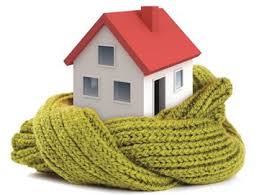Home Energy Efficiency
Make your home cosier and healthier whilst reducing energy bills and carbon emissions.
Home Energy Efficiency
Improving the energy efficiency of your home is one of the simplest ways to save energy and reduce bills.
A typical home could save up to £250-£300 a year by being more energy efficient and many of the measures are simple to install.
The first step is to understand where your home may be losing heat…this will help you decide on the measures which will have the most impact first. And the good news is there are often grants and discounts available which make it an even smarter choice.

Home Insulation
There are many simple yet effective ways to insulate your home, which can significantly reduce heat loss while also lowering your heating bills.
The best approach is to tackle the areas of largest heat loss first in terms of walls, attic, windows and doors.
- In a house with no or poor insulation the biggest heat loss, around a third, will be through the walls. By properly insulating walls (whether you have solid or cavity walls) will save energy and cut costs off your heating bill.
There are three different ways to insulate your walls; cavity, external and internal wall insulation.
Cavity Wall Insulation
If your home has cavity walls which are not insulated, or only partially insulated, then cavity wall insulation is an easy, cost effective first step to reduce heat loss. This is not a job you can do yourself; you will need to employ a registered installer. The process should only take a few hours for a typical house and shouldn’t make any mess.
A series of small holes are drilled in the wall, at regular intervals, on the outside. The insulation is then pumped into the cavity through these holes, and the holes are filled in so that they match the rest of the wall.
– Cost (depends on house type): £345 – £610
- Saving per year: £90 – £305
- Payback: Around 2-3 years.
- Grants and Support [link through to grants/support page]
Solid Wall Insulation
Unlike cavity walls, solid walls do not have a gap which can be filled with insulation. Solid walls let through twice as much heat as cavity walls do! That is why solid wall insulation can help you reduce significantly your energy bills.
Solid walls can be insulated from the outside or inside of your home, and often its best (to keep the cost down) to do this when you are getting other work done.
External Wall Insulation
For solid block or concrete walls with no cavity, external wall insulation is generally the preferred option. This involves wrapping a layer of rigid insulation around your home, fixing it to the walls, embedding mesh in it to provide strength, and covering it in a render to provide weather resistance.
Internal Wall Insulation
If external insulation is not suitable internal wall insulation might be recommended for your home. Internal insulation (sometimes referred to as ‘drylining’) usually involves fixing insulation boards to the inside of the external walls and covering them with a vapour control layer, plasterboard, skim and new painting.
– Cost* (depends on house type): £3k – £14K (internal insulation) £5k – 18k
(external insulation)
- Saving per year: £260 – £660 per year
- Payback: Around 1-2 years.
- Grants and Support [link through to grants/support page]
*Costs will vary significantly depending on the work required. You might be able to reduce these costs by carrying out the work at the same time as other home improvements or by not tackling all the house at once.
Roof and Loft Insulation
Heat rises, and in an uninsulated or poorly insulated home, 25% of heat can be lost through the roof. Insulating your loft, attic or flat roof is a simple and effective way to reduce heat loss and reduce your heating bills.
- COST (depends on house type): £285 – £395
- Savings per year: £145 – £275
- Payback: Around 1-2 years.
- Grants and Support [link through to grants/support page]
Loft insulation is easy to install – you can even do it yourself. Even if you already have loft insulation, check its thickness. Adding another layer to bring it up to the recommended 270 mm will save energy and money.
Insulating your ground floor is a great way to keep your property warm and can reduce heat loss by 10%-15%. Generally speaking, you only need to insulate the ground floor. If you’re on an upper floor, you don’t usually need to insulate your floor space.
Different approaches will be needed depending on whether you have a solid ground floor, a suspended concrete floor or a suspended timber floor. In some cases it may be possible to lay insulation on top of the existing construction or in other cases it will be necessary to fit insulation to the underside of the concrete or timber structure.
Gaps and draughts around skirting boards and floors are simple to fix yourself with a tube of sealant bought from any DIY store.
– Cost (depends on house type): £520 – £1,300
- Saving per year: £40 – £90
- Payback: Around 5 to 8 years.
- Grants and Support [link through to grants/support page]
Home Improvements, Draught Proofing and Lagging
- [Image] Window and Doors
All homes lose heat through their windows. You can lose about 10% of your home’s heat through your windows and doors depending on the age of your existing windows. If you’ve got well insulated walls and attic, then the heat lost through poorly performing windows and doors will be even greater.
But energy-efficient glazing keeps your home warmer and quieter as well as reducing your energy bills.
The disadvantage is the cost of replacing all the windows in your home. The costs and savings will be different for each home and each window but could save up to £200 per year. Double glazing should last for 20 years or more.
Choosing an Energy Efficient Window
The energy performance of a window is influenced by a wide range of factors, so it’s not easy to choose a window by looking at how it’s made. Fortunately, there’s a rating scheme to help you find the most efficient.
Window manufacturers can show the energy efficiency of their products using an energy-rating scale from A++ to E. The whole window (the frame and the glass) is assessed to allow for heat loss, draughts and solar gain, giving a rating that indicates the overall impact of fitting that window in your home.
U-values
Windows that have an energy rating will have the u-value of the window displayed on the energy label, and you may see u-values quoted for windows without a label
A u-value is a measure of how easily heat passes through a material, but it is not a complete measure of how efficient a window us. The overall label rating will give you a better indication of the window’s energy saving potential.
- [Image] Draughtproofing
Draught-proofing is one of the cheapest and most efficient ways to save energy – and money.
Draughts happen where there are unwanted gaps in the construction of your home, and where openings are left uncovered. You’ll find draughts at any accidental gap in your home that leads outside
And If you’re happy carrying out simple DIY tasks, draught-proofing will be no problem.
Controlled ventilation helps reduce condensation and damp, by letting fresh air in when needed. However, draughts are uncontrolled: they let in too much cold air and waste too much heat. To draught-proof your home you should block up unwanted gaps that let cold air in and warm air out. Saving warm air means you’ll use less energy to heat your home, so you’ll save money as well as making your home snug and pleasant
The main places to draught-proof are your floors, windows, doors and chimney and all can be done for a relatively low price. Draught-proofing around windows and doors could save you around £20 per year. If you have an open chimney, draught-proofing your chimney when you’re not using it could save around £15 per year.
- Windows: For windows that open, buy draught-proofing strips to stick around the window frame and fill the gap between the window and the frame.
- Doors: Draught-proofing outside doors can save a lot of heat and will only cost you a few pounds. The main things to consider are the keyhole, letterbox and any gaps around the bottom or edges of the door.
- Chimney: If you don’t use your fireplace, your chimney is probably a source of unnecessary draughts. But you can either fit a cap over the chimney pot or buy a chimney draught excluder
- Floorboards and Skirting: You can block cracks by squirting filler into the gaps. Floorboards and skirting boards often move slightly with everyday use, so you should use a filler that can tolerate movement – these are usually silicone-based. Fillers may break down over time, but can easily be reapplied.
Draughtproofing the entire home can cost around £120 to £150 but can save you up to £65 a year on energy.
- [Image] Lagging
Lagging water tanks and pipes and insulating behind radiators reduces the amount of heat lost, so you spend less money heating water up, and hot water stays hotter for longer.
Hot Water Tank
Insulating your hot water cylinder (to 75mm) is an easy way to save money. Fitting it is straightforward and could save you around £25-£35 a year, so with the cost of a jacket round £15 it pays for itself in less than a year.
Pipe insulation consists of a foam tube that covers the exposed pipes between your hot water cylinder and boiler, reducing the amount of heat lost and, therefore, keeping your water hotter for longer. Again, it’s easy to fit and should cost around £20.
Radiator Reflector Panels
If you’re trying to save money on your heating bills and reduce your energy consumption, radiator reflector panels are an attractive low-cost option.
Fixed behind your radiators, they reflect heat from the radiator back into the room, instead of letting the heat out through an external wall. Remember, you only need to put reflector panels behind radiators on external walls.
Budget Energy to increase electricity prices by 4%
Budget Energy is the latest electricity supplier to announce a price increase for their customers. Northern Ireland’s third largest electricity supplier has confirmed that it
Power to Switch partners with Local Women Awards 2025 as headline sponsor
Power to Switch has one big mission: championing and empowering local people. The Local Women Awards 2025 share that same spirit – so coming on
57 Energy Saving Tips, as Told By Our Users
When it comes to saving energy, sometimes the best advice doesn’t come from experts – it comes from people just like you. We asked our
Stay in the know...
Keep up to date with all the latest energy news, deals and advice from Power to Switch

